Enjoy this guest article from OTI Reader Geoffrey Wessel!
Road movies might be the most American of all genres in film. With the possible exception of the Western (and some Westerns, it should be noted, are road movies), what other framework has baked into it more signifiers of the history, mythology, national symbols, and best and worst parts of the lived experience of the U. S. of A.? What setting offers a better backdrop for examining America’s freedom, rootlessness, yearning, adventure, and struggle than no setting – the between place – the road itself, rather than the destination? Road movies are an ideal mode of expression for a young country, a nation of the frontier, of pioneers and explorers of the great unknown, willing to cut the ties of “home” and move on to new horizons. Also a nation of people who love cars.
It is not surprising, then, that the theme of liberation initiates the action of many great road movies. Take for example the opening scene of The Blues Brothers, in which “Joliet” Jake Blues (John Belushi, peace be upon him) is released from prison and picked up by his “blood brother” Elwood (Dan Aykroyd).
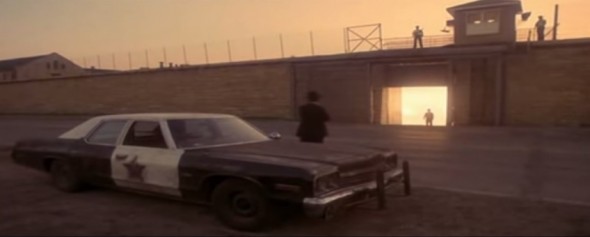
The sepia filter lets you know that this will be an emotional reunion.
The 2000 remake also opens with the protagonist departing from a prison, but with the twist that this time around, it’s an illegal escape from a chain gang (working on, incidentally, road maintenance) and that it’s three protagonists making a break for it. The sepia filter (well actually, post-production color correction, in this case) and the swooping crane shot with a vehicle in the foreground are still in the picture.
Wait, did you think I was talking about Blues Brothers 2000? No, that’s the sequel (and was released in 1998). The remake has a different title, though they kept the word “Brother.”
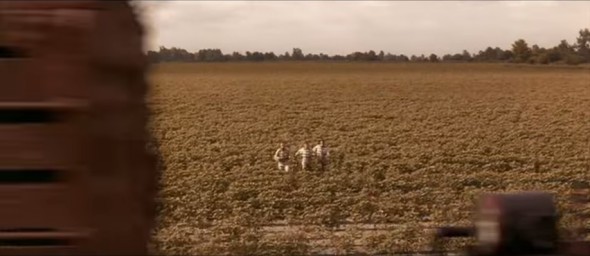
The train speeding by in the foreground is a metaphor for freedom.
Okay, yes, technically, O Brother, Where Art Thou? is not a remake of The Blues Brothers. But… maybe it is?
The Coen Brothers’ (that word again!) epic and music-tastic road movie O Brother, Where Art Thou? (henceforth OBWAT) features a journey by “bros” who are not actually biological brothers urgently seeking a “great fortune” by driving through parts of rural America. So does The Blues Brothers (BB to me, because I am, in fact, “into the whole brevity thing”). And yes, all of that is also true of a lot of great road movies – these sorts of things are almost genre conventions, or at least popular tropes going back a long way. And “brotherhood,” or examination of the theme of fraternal ties that are simultaneously friendships and rivalries, has been a major aspect of road movies for decades, as epitomized in the famous “Road” series starring Bing Crosby and Bob Hope.
But the connections between these two films go much deeper. OBWAT is not shy about drawing from multiple sources of inspiration. The credits tell us it is based on The Odyssey – the great grandpappy of all road movies. The title is a reference to a classic road picture from 1942 whose own title links back to Gulliver’s Travels, another pre-celluloid milestone in episodic travel-focused narrative entertainment. In both cases, the relationship is more one of multiple references rather than direct transposition of story elements. And when it comes to references in common, OBWAT and BB have a surprising number of links – almost like they’re… brothers.
Previous articles on Overthinking It have discussed the circumstances in which remaking a classic can add value. Considering OBWAT as a remake of BB lets us look at how the culture changed in the intervening two decades between the films. In particular, the differences between these two works throw a spotlight on OBWAT’s highly sophisticated contemplation of American consumerism and social progress hidden in what appears on the surface to be a fun romp. It certainly is a fun romp, but at the same time, the movie offers a serious and nuanced critique of what it portrays as a culture that increasingly prioritizes appearance over reality, to the detriment of both personal and cultural growth.
Spoilers for both movies from here on out.
“Don’t Drive Like My Brother”
After the opening liberation, the protagonists in both movies have just a few days to collect a specific large sum of money. The deadline in BB is a countdown to the closure of the orphanage where the “blood brothers” grew up; in OBWAT it is the literal submergence of the home of group leader Ulysses Everett McGill (George Clooney) under the waters of a new reservoir, making the $1.2 million he robbed from an armored car (note the prominent automobile) forever inaccessible. So the urgency in both movies is related to a threat to the hero’s home.
Both versions are highly episodic (as road movies in general, again, tend to be). In both, one of the early set pieces involves evading the pursuing law enforcement officers by driving a car through a building (a plot element shared by a much smaller percentage of road movies).
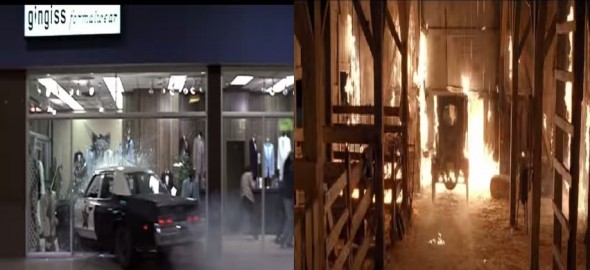
The decision to have the barn be on fire is an easy way of raising the stakes in the remake, as is the choice to add an exploding police wagon (yes, another car) to the scene.
Speaking of being chased by the cops, in both movies the heroes are simultaneously pursued by the law and by white supremacists whose rally the heroes had disrupted, turning it into a chaotic farce. The “Illinois Nazis” in BB mock a real-life group that won a Supreme Court case allowing them to demonstrate in a public park, and the KKK depicted in OBWAT similarly draws on the real-life atrocities the Klan was committing in the time and place where the film is set.
I challenge you to name any other movie besides these two featuring an automobile driving around with a loudspeaker mounted on it to urge people to take some action, including through rural areas where the camera emphasizes only one person is listening. (In BB, it’s the brothers seeking an audience for their concert; in OBWAT, it’s Homer Stokes campaigning for governor.) In BB, it is Jake’s love interest who wishes him dead (as demonstrated by her repeated attempts to murder him); in OBWAT, Everett’s ex-wife tells their children that he was killed by a train (another vehicle reference). Elwood in BB is comically obsessed with toast; Everett in OBWAT with pomade.
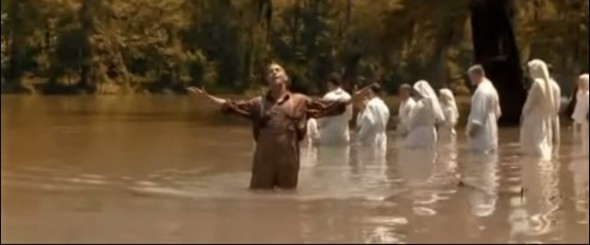
“We’re on a mission from God.”
The incorporation of these parallels into OBWAT connects it to a highly successful and critically acclaimed cultural touchstone. But more than just copying enjoyable elements of BB, the team behind OBWAT used nearly every one of these examples of influence to layer on a comment about a particular theme: the theme of truth versus deception, appearance versus reality. The Blues Brothers drive around getting people excited about a concert, and the concert really is exciting. Everyone shows up and has a great time. In contrast, Homer Stokes’s gubernatorial campaign is cynical, manipulative, and gimmicky. His portrayal on screen makes it clear that he is not actually as concerned about “the little man” as he pretends to be, but simply uses that narrative as an effective means of advancing his own political ambitions. Carrie Fisher’s character in BB uses bombs and machine guns in her actual murder attempts; Holly Hunter in OBWAT just lies to her children, telling them that their father is dead. These approaches represent two very different ways to bring about change: actually changing the underlying reality, or using storytelling to change the consensus perception of reality. Even Elwood’s toast is “real,” in that food is necessary to survival, while Everett’s hair treatment connects to the merely cosmetic projection of an appearance of health and vitality.
Another common element in both films is the major role of the setting. BB relishes in celebrating Chicago and surrounding parts of Illinois, featuring symbols such as Wrigley Field, and OBWAT is equally focused on the fields, swamps, and small towns of 1930s Mississippi. Both films emphasize the poverty of these areas, and both suggest that this poverty fosters a rich musical tradition: blues, soul, and R&B music in BB; bluegrass, folk, country and delta blues in OBWAT.
Both sets of protagonists are virtuoso musicians, and many of the other characters they encounter also shine as musical performers. Both films take time out from the story to showcase musical numbers. In BB, the first act of the movie involves traveling around to pick up various band members. One of them is the black guitar legend Matt Murphy. In OBWAT, this plotline is mostly dropped, but has one remnant in the scene where they pick up black guitar legend Tommy Johnson. In BB, Jake’s smooth talk gets the group a gig playing music at a bar; in OBWAT, Everett’s smooth talk gets them a gig playing at a radio station. And a climactic concert performance by the protagonists in both films gets them nearly to their goal, but still leaves an important challenge unfinished: the return trip to Chicago in OBWAT, and the return to Everett’s house in BB, with the lawmen in both cases trying to frustrate the culmination of their plans.
Alle Menschen Werden Brüder
And now that we are talking about the music, let’s consider a highly significant difference between BB and OBWAT. In the former, actual musicians appear center stage in the film: legends like James Brown, Aretha Franklin, and Ray Charles. Audiences know them and love them. They steal the scene for high-profile musical numbers at regular intervals. The Coens’ picture also showcases the soundtrack, with its own rotation of musical numbers taking place diegetically within the movie but interrupting the flow of the plot. But something has changed dramatically: we hear Dan Tyminski’s vocals, but we see George Clooney at the microphone. Clooney, the actor, is the one we know and love. The audience is not expected to have ever heard of Tyminski, and some viewers in fact do not even realize that the singing is dubbed.
In the imaginary world where OBWAT is a deliberate remake of BB, this difference is not an accident. Look at the recurring motif throughout OBWAT of sight, blindness, vision, appearance, and images. In 2000, what you see is not what you get. The disparity between appearance and reality, and the fact that we don’t really care what the reality is as long as the appearance suits us, is a commentary on the growing sophistication of advertising and the slickness of the entertainment industry. Even “old-timey” country music in the 21st century is mass-produced for a mass audience, packaged up in a sexy George Clooney wrapper, compared to the putatively “authentic” music of 1937 or even 1980 (the year the original Blues Brothers came out). The movie itself, as alluded to above, was extensively altered through digital color correction, giving it a distinctive burnt yellow appearance that goes beyond a simple faithful photographic report.
In vehicular terms, sometime in the 1990s, sales of SUVs overtook those of passenger cars in the United States. One of the major drivers for this switch was that piloting an SUV makes motorists feel safer than driving a regular car – even though, paradoxically, the SUV’s higher center of gravity actually make the vehicles more prone to rollovers. When it comes to appearance versus reality, advertisers and consumers choose appearance. The Coens may or may not be condemning or even merely commenting on this cultural shift by participating in it, but certainly they are participating in it. At the same time, OBWAT retains BB’s interest in exploring the role of music as an artistic mode of expression available to a subaltern socioeconomic class, and the perpetual struggle between members of that class and the statutory authority.
At the end of The Blues Brothers, the protagonists have succeeded in raising the money needed to save the orphanage, even though they all end up in jail immediately afterward. But that imprisonment is not depressing – it is joyous, with the whole band together putting on an electrifying performance of Elvis Presley’s “Jailhouse Rock.”
The ending of O Brother, Where Art Thou? looks much more optimistic on the surface, but again, appearances belie reality. Rather than retrieving the buried treasure, it turns out that the treasure never existed. Let me emphasize that again: it turns out the that the treasure never existed. It was all a fabrication, made up by Everett in order to manipulate his partners into helping him fulfill a personal objective. Nevertheless, the protagonists instead do find another sort of success, being elevated to high positions in the state government – but only because of the corruption and nepotism that pervades the system. Everett is finally reunited with his family – but is that reunion really final? Or has Penelope, by demanding the retrieval of a wedding ring presumably lost at the bottom of a 9,000 hectare lake, unwoven the burial shroud not on behalf of the usurping suitors, but as a challenge to the rightful husband? Everett’s final speech is full of optimism about modernization and the progress that electrification will bring to a New South – but the final, enigmatic image is the blind traveler and soothsayer, evoking the persistence of superstition and a connection with the past that no progressive idealism can truly sever.
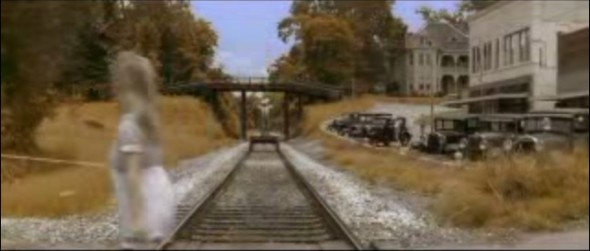
In short, for all its deliberate wild implausibility, the original Blues Brothers has a relationship with earnestness and truth that made a hit with audiences at the end of the 1970s but could not survive at the start of the 21st century. Instead, O Brother subverts those elements in a brilliant commentary on deception, spin, and the power of storytelling.
Geoffrey Wessel is an American diplomat and philosopher. He is the author of the iambic pentameter version of the United States Constitution and Bill of Rights.
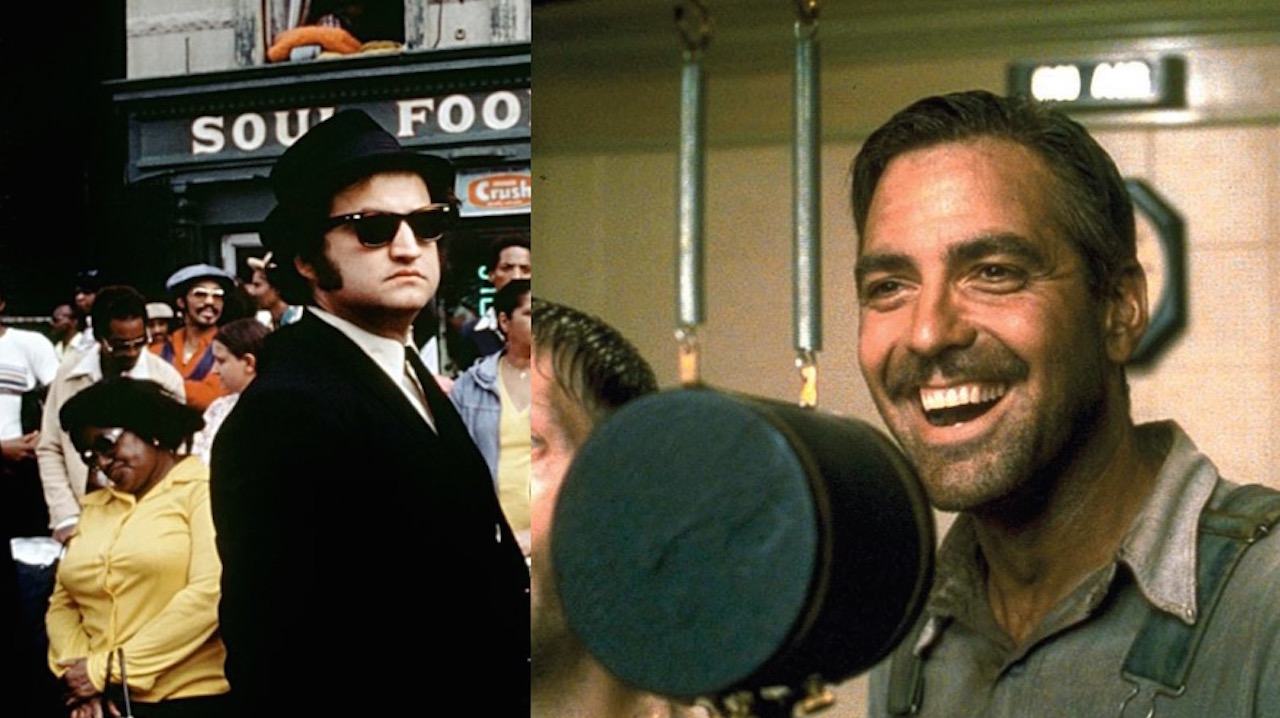
At the risk of hitting the “well actually” button… Given that The Muppets (2011) is a remake of Blues Brothers, does it also make it a remake of OBWAT?
The comparison (shamelessly copied from the “You’re a Ninja Harry” OTI Newsletter reply:
Brothers Jake and Elwood / Walter and Gary visit their former/spiritual home at the the Orphanage/Muppet studios and find that, due to outstanding debts it is to be sold for commercial development.
They then go to a spiritual leader Cleophus James/Kermit the Frog and come to the revelation that a concert/show will allow them to raise the funds necessary to save the property.
They see a major problem because the band/Muppets have gone their separate ways since Jake’s imprisonment/The Muppet Show ended its run. The only possible solution is a road trip to get the band back together.
The first visit is to engage a large portion of the group, who are performing as a second-rate lounge act “Murph and the Magictones”/”The Moopets”.
They then visit one member of the crew that has gone on to relative success: Alan Rubin/Gonzo. He is harder to convince, but despite his initial objection, decides to destroy his job/business and join them.
Matt “Guitar” Murphy/Animal is rescued/recovered from their sedated lives after being warned by Aretha Franklin/Jack Black to avoid returning to their former lifestyle that put them in trouble in the first place.
The group pitch their show idea but are unsuccessful. After contacting a producer/executive the re-formed group performs their first performance at Bob’s Country Bunker/The Theater. This first performance is not a success.
Through extortion/kidnap, the group successfully passes the hurdle for their major performance.
The show turns out to be a major success, except that one last hurdle from the Police/Tex Richman attempting to stop them from completing their goal.
Exiting the theater, the brothers are greeted by supporters who provide the last of the funds necessary to keep the orphanage/theatre open.
Once the orphanage/theatre is saved, one last musical number will take you to the credits.
Differences:
– The car chases in the Blues Brothers have no real equivalent in the Muppets.
– The Miss Piggy in Paris substory has no equivalent.
– Dan Ackroyd originally had stories for the sourcing of each band member. When the script came in at 324 pages, the options were to gather the rest through a montage, or to have them play in Murph and the Magictones. John Landis chose the latter. The Muppets chooses the former.
– There’s a tenuous link between the Mystery Woman and Mary, but a much clearer one between the Penguin and the Penguins :)